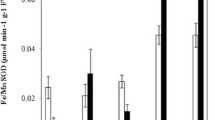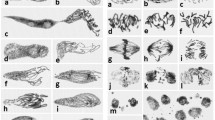Abstract
Intact and excised cultured pea roots (Pisum sativum L. cv Alaska) were treated with chlorsulfuron at concentrations ranging from 2.8 ×10−4 M to 2.8×10−6 M. At all concentrations this chemical was demonstrated to inhibit the progression of cells from G2 to mitosis (M) and secondarily from G1 to DNA synthesis (S). The S and M phases were not directly affected, but the transition steps into those phases were inhibited. Total protein synthesis was unaffected by treatment of intact roots with 2.8×10−6 M chlorsulfuron. RNA synthesis was inhibited by 43% over a 24-h treatment period. It is hypothesized that chlorsulfuron inhibits cell cycle progression by blocking the G2 and G1 transition points through inhibition of cell cycle specific RNA synthesis.
Similar content being viewed by others
References
DeVilliers OT, Vandenplas ML, Koch HM (1980) The effect of DPX-4189 on biochemical processes in isolated leaf cells and chloroplasts. Proc 1980 Brit Crop Prot Conf—Weeds, pp 237–242
Evans HJ (1965) Effects of radiations on meristematic cells. Rad Bot 5:171–182
Gomori G (1952) Microscopic histochemistry: Principles and practice. University of Chicago Press, Chicago, Illinois, USA
Mitchell JP (1969) RNA accumulation in relation to DNA and protein accumulation in Jerusalem artichoke callus cultures. Ann Bot 33:25–34
Ray TB (1980) Studies on the mode of action of DPX-4189. Proc 1980 Brit Crop Prot Conf— Weeds, pp 7–14
Ray TB (1982) The mode of action of chlorsulfuron: A new herbicide for cereals. Pest Biochem Physiol 17:10–17
Rost TL (1977) Responses of the plant cell cycle to stress. In: Rost TL, Gifford EM, Jr (eds) Mechanisms and control of cell division. Dowden, Hutchinson and Ross, Inc, Stroudsburg, Pennsylvania, USA, pp 111–143
Van't Hof J (1968) Control of cell progression through the mitotic cycle by carbohydrate provision. J Cell Biol 37:773–778
Van't Hof J (1974) The duration of chromosomal DNA synthesis, the mitotic cycle and meiosis in higher plants. In: King RC (ed) Handbook of genetics. Plenum Publishing Co, New York, Vol 2, pp 363–377
Van't Hof J, Kovacs CJ (1972) Mitotic cycle regulation in the meristem of cultured roots: The principal control point hypothesis. In: Miller MW, Kuehnert CC (eds) The dynamics of meristem cell populations. Plenum Press, New York, pp 15–30
Webster PL, Van't Hof J (1970) DNA synthesis and mitosis in meristems: Requirements for RNA and protein synthesis. Amer J Bot 57:130–139
White PR (1943) A handbook of plant tissue culture. Cattel & Lancaster, Pennsylvania
Wilt FH, Wessells NK (eds) (1967) Methods in developmental biology. TY Crowell Co, New York, p 605
Author information
Authors and Affiliations
Rights and permissions
About this article
Cite this article
Rost, T.L. The comparative cell cycle and metabolic effects of chemical treatments on root tip meristems. III. Chlorsulfuron. J Plant Growth Regul 3, 51–63 (1984). https://doi.org/10.1007/BF02041991
Received:
Accepted:
Issue Date:
DOI: https://doi.org/10.1007/BF02041991




